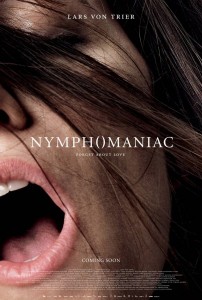film review: nymphomaniac
‘That was like Gone With the Wind!’ the woman behind me exclaimed, as the final credits began for Lars von Trier’s Nymphomaniac rolled. Running at 241 minutes, or just over four hours, one could certainly make the comparison. Von Trier’s epic does span the protagonist’s lifetime, but as opposed to Scarlett O’Hara, Joe’s war only has one soldier and one enemy, Joe herself.
Lars von Trier is perhaps best known for his role in the Dogme 95 movement: directors follow a set of rules designed to showcase raw emotion. This includes the use of handheld cameras, and rules out special effects, artificial sounds, lights or sets. Von Trier’s connection to the movement has been evident in all of his films up until his 2009 art house film, Antichrist, a very stylised horror film. This was followed by another heavily stylised sci-fi, Melancholia (2011) and now Nymphomaniac, perhaps his most cinematic film to date.
Whilst haters of ‘queasy-cam’, a term coined by our own David Stratton, will rejoice at von Trier’s conformity to the cinematic style, lovers of the raw emotion and melodrama of von Trier’s films may be severely disappointed. The very realness the Dogme was designed to protect is somewhat diffused by the gentle panning and operatic crescendos accompanying black and white slow motion sex scenes.
Nymphomaniac struck me as von Trier’s most selfish film, wondering why on Earth anyone would devote four hours to a woman who believes she is ‘a bad human being’ telling a stranger all about her sexual history, only to explain why he found her beaten up in an alley at the film’s opening.
Von Trier spaces the sections of Joe’s story into chapters that she names after things she can see in this stranger’s apartment. Whilst this is slightly funny at times, I found it irritating, as the von Trier I love doesn’t allow the audience breathing room in an otherwise tragic story. I realised his sole motivation for adding these discussions was to parade his own personal knowledge of obscure things such as fly fishing, the Fibonacci sequence and Edgar Allen Poe to the audience in a supremely self indulgent cry for attention.
Some segments of the film were stunningly heavy, such as Uma Thurman’s cameo as the cavalier yet distraught abandoned wife of one of young Joe’s lovers, where her uneasiness seeps through the screen like a virus encapsulating the audience. And of course Joe’s disturbing experimentation with BDSM that has the eerie ability to be sexually exciting and emotionally horrifying at the same time. Yet all the while I was longing for the figurine breaking scene in Dogville or the final scene in Dancer in the Dark, and nothing even came close.
I feel it would be remiss of me not to mention Shia LaBeouf whilst I’m in the grievances section of this article. Maybe it was clever of von Trier to cast him, because his accent was so confusing that I couldn’t pull my attention to his acting long enough to determine whether it was just bad, or really bad. But then I’m of the opinion LaBeouf hasn’t done anything good since Even Stevens.
And whilst Ananya Berg, who played ten year old Joe did very well, I couldn’t help but be angry at the casting of a little girl who looks nothing at all like Charlotte Gainsbourg, least of all in her bright blue eyes, which completely belie any suspension of disbelief.
But the film wasn’t all disappointing. First time screen actress Stacy Martin, who played young Joe and featured prominently in the first half of the film, made her presence known. Her depth and sheer force in some heavy and difficult scenes never wavered.
However nothing and no one in the film could compare to Charlotte Gainsbourg’s breathtakingly sublime acting as Joe. There are not enough words in the English language (or the little French or Japanese I know) to articulate how astonishing a performance Gainsbourg gave. She held on so perfectly to a raw, childlike innocence, a total submission to her addiction, that even in the harsh utterances of the word ‘cunt’ and her ordering to have men ‘fill all (her) holes’, she maintained a grace akin to doe, perhaps being eaten by a jaguar, but still so poignantly calm.
Whilst the delivery failed a little, von Trier’s message in Nymphomaniac is clear (especially considering he made Stellan Skarsgård’s character explicitly state it), that we should all be comfortable expressing our own sexuality, unless you’re a paedophile in which case you ‘deserve a bloody medal’ for suppressing it. That if men behaved the way Joe did, it wouldn’t be considered bad, but because she’s a woman she’s made to feel guilty for her lust. It’s an important message, which is sad in a way.
Nymphomaniac had its great points and its failures. I can’t decide whether I liked it or not overall. But it did make me realise that lust and guilt shouldn’t be the same feeling, a message all women need to hear.


